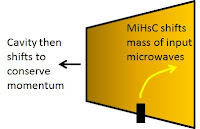It is crucial to pay close attention to new data, and observational astrophysicist Prof Stacy McGaugh has a habit, like John Anderson, of writing nicely concise analyses of new data that are easy to test against. McGaugh, Lelli and Schombert have just published a paper comparing the data from 153 different galaxies across a large range of scales from dwarfs to large disc galaxies, looking at two things 1) the acceleration within them as predicted using standard dynamics from their baryonic (visible) mass only (g_bar, x axis in the Figure), and the actual acceleration as determined from the observed motion of their stars (g_obs, y axis). The result is shown on a log-log plot here (from McGaugh and Lelli, 2016):
If Newton or Einstein's general relativity were right (without the crutch of dark matter) then you would expect the data to lie along the faint straight diagonal line, so that the predicted acceleration would equal that observed. It does not. As you can see the data lifts from the straight line on the left hand side because for lower accelerations the stars' orbital speed, and therefore acceleration, is greater than expected. This is the famous galaxy rotation problem noticed by Zwicky (1933) and Rubin & Ford (1980). The majority of astrophysicists fix this by adding dark matter to the galaxies where it's needed, but that is an ad hoc solution that no-one should have to resort to in a scientific age. In the paper, McGaugh and Lelli fit a curve to this data using this formula
and show it predicts well if the fitting parameter 'gt' is set to the value 1.2x10^-10 m/s^2 and both McGaugh and Lelli, and Milgrom in a note published soon after, say this looks like some of the possible variants of MoND (Modified Newtonian dynamics). Milgrom in his note even says 'nothing else can give this behaviour' but this is simply not true. MiHsC / quantised inertia also predicts this behaviour far more plausibly and simply than MoND, and without any adjustment at all. The MiHsC formula can be found in McCulloch (2012) (see Eq. 6 in the ref below, and note the comments on a' therein. The Eq. I showed before is based on Eq. 7 and is less general). The MiHsC formula (note, only strictly valid at a galaxy's edge) is
This formula is based on a specific physical model (MiHsC: Unruh waves harmonise with horizons and cause inertia) unlike MoND which is just an empirical relation with no physical model. It is obviously much simpler than McGaugh & Lelli's formula, and crucially there are no fitting parameters in MiHsC/quantised inertia at all! Its predictions of g_obs are exactly right see Figure below and are predicted from just the known quantities of the speed of light (c) and the size of the observable universe (Theta=8.8x10^26 m):
I do feel a bit like a broken record going on about this, but it's necessary because it has not yet been widely appreciated that a theory that predicts real data without any fitting parameters, like MiHsC does, is like a diamond in the mine. Like special relativity, it is a sign of something fundamental.
(Note: MoND is a bit like the early twin patchwork formulas of Wien & Rayleigh-Jeans for blackbody radiation, whereas MiHsC/QI is like the quantum mechanics of Planck et al. which predicted it more concisely with a shocking new assumption).
I do feel a bit like a broken record going on about this, but it's necessary because it has not yet been widely appreciated that a theory that predicts real data without any fitting parameters, like MiHsC does, is like a diamond in the mine. Like special relativity, it is a sign of something fundamental.
(Note: MoND is a bit like the early twin patchwork formulas of Wien & Rayleigh-Jeans for blackbody radiation, whereas MiHsC/QI is like the quantum mechanics of Planck et al. which predicted it more concisely with a shocking new assumption).
References
McGaugh, S.S, F. Lelli, J. Schombert, 2016. The radial acceleration relation in rotationally supported galaxies. Phys. Rev. Lett. (to be published). Preprint.
McCulloch, M.E., 2012. Testing quantised inertia on galactic scales. Astrophysics and Space Science, 342, 342-575. Preprint








